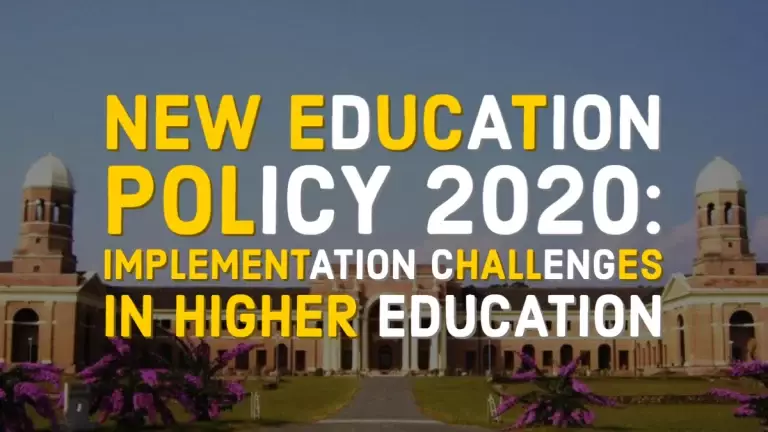The National Education Policy, NEP 2020 aims to revolutionize the Indian education system with a comprehensive framework that addresses early childhood education to higher education and vocational training. However, the successful implementation of NEP 2020 has encountered several hurdles that need urgent attention to realize its full potential. In this blog post, we will delve into the significant challenges and opportunities associated with the NEP 2020, offering a nuanced understanding of its implementation.
Table of Contents
Understanding NEP 2020
The NEP 2020 is an ambitious policy introduced by the Indian government to overhaul the education system and make it more inclusive, flexible, and aligned with the needs of the 21st century. The policy emphasizes critical thinking, holistic and multidisciplinary education, skill development, and the integration of technology in education. It aims to increase the Gross Enrollment Ratio (GER) in higher education to 50% by 2035, establish numerous new universities, and bring back millions of out-of-school children into the educational fold.
Key Challenges in Implementing NEP 2020
1. Financial Constraints
One of the most daunting challenges in implementing NEP 2020 is the financial requirement. The policy envisions increasing public spending on education from 4.6% to 6% of GDP, which translates to approximately INR 2.5 lakh crores annually (India Today) (TheProbe). However, the economic impact of COVID-19, coupled with pre-existing fiscal deficits, has made it difficult to secure the necessary funds. Allocating sufficient resources to build new schools, colleges, and universities, as well as to improve existing infrastructure, is critical but remains a significant hurdle.
2. Infrastructure and Human Resources
The NEP’s ambitious goals require substantial infrastructural development and a massive increase in the number of trained educators. For instance, to achieve the target GER, India would need to open one new university every week for the next 15 years (India Today). Similarly, integrating 2 crore out-of-school children into the education system demands the establishment of approximately 50 new schools each week, alongside hiring hundreds of thousands of teachers and headmasters (TheProbe). The current shortage of trained teachers and the inadequacy of educational infrastructure pose significant barriers to these goals.
3. Pedagogical Shifts and Teacher Training
The NEP 2020 advocates for a paradigm shift in teaching methodologies, promoting interdisciplinary and holistic education. Implementing these changes requires extensive retraining of the existing workforce, which is both time-consuming and resource-intensive. Teachers must be equipped to handle new curricular requirements and pedagogical approaches, fostering critical thinking and problem-solving skills among students (INSIGHTS IAS).
4. Multilingualism and Language Policy
The policy’s emphasis on a three-language formula—promoting Hindi, English, and a regional language—has sparked concerns about the marginalization of regional languages. Critics argue that this approach disproportionately favors Hindi and English, potentially undermining linguistic diversity and regional identities (INSIGHTS IAS) (RISE Programme). Balancing the promotion of national unity with respect for regional languages and cultures remains a contentious issue.
5. Governance and Stakeholder Engagement
Effective implementation of NEP 2020 requires robust governance and genuine stakeholder engagement. Critics have pointed out that the policy formulation process lacked comprehensive consultation with all relevant stakeholders, including educators, students, and marginalized communities (TheProbe). Ensuring broad-based participation and buy-in from all sectors of society is essential for the policy’s success.
6. COVID-19 Impact
The COVID-19 pandemic has severely disrupted the education sector, exacerbating existing challenges and creating new ones. Prolonged school closures have widened the learning gap, especially among students from disadvantaged backgrounds (RISE Programme). Addressing these learning losses and ensuring continuity of education through innovative solutions, such as online and blended learning, is critical but fraught with difficulties.
Opportunities for NEP 2020
Despite these challenges, NEP 2020 also presents significant opportunities to transform the Indian education system.
1. Emphasis on Skill Development
The NEP’s focus on vocational education and skill development is a positive step towards aligning education with industry needs. By emphasizing practical skills and employability, the policy can help bridge the gap between education and employment, preparing students for the demands of the modern workforce (TheProbe).
2. Integration of Technology
The policy advocates for the integration of technology in education, promoting digital literacy and the use of digital tools in teaching and learning. This can enhance access to quality education, particularly in remote and underserved areas, and support personalized learning experiences (RISE Programme).
3. Holistic and Multidisciplinary Education
NEP 2020 encourages a holistic approach to education, fostering not only academic excellence but also the overall development of students. This includes physical education, arts, and social and emotional learning, creating well-rounded individuals capable of critical thinking and problem-solving (TheProbe).
4. Decentralized Governance
The policy calls for a more decentralized approach to educational governance, giving greater autonomy to schools and higher education institutions. This can enable more context-specific and responsive educational practices, tailored to the unique needs of different regions and communities (RISE Programme).
5. Focus on Foundational Literacy and Numeracy
The NEP emphasizes the importance of foundational literacy and numeracy, recognizing that early learning is critical to long-term educational success. By prioritizing these basic skills, the policy aims to ensure that all students acquire the necessary competencies to succeed in their educational journey (INSIGHTS IAS).
Conclusion
The NEP 2020 represents a bold vision for the future of education in India, offering numerous opportunities to enhance educational outcomes and promote holistic development. However, its successful implementation hinges on addressing significant challenges related to funding, infrastructure, teacher training, governance, and stakeholder engagement. By fostering collaboration among policymakers, educators, and communities, and by leveraging technology and innovative practices, India can overcome these hurdles and realize the transformative potential of NEP 2020.
As India navigates the complexities of implementing this ambitious policy, it is crucial to maintain a focus on inclusivity, equity, and quality. Only through sustained effort and commitment can the goals of NEP 2020 be achieved, paving the way for a brighter future for India’s students and society as a whole.


